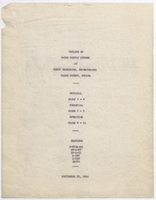Search the Special Collections and Archives Portal
Search Results
Antonio Morelli Papers
Identifier
Abstract
The Antonio Morelli Papers (approximately 1910-1989) consist of photographic prints and slides, scrapbooks, concert programs, correspondence, and audio recordings that chronicle the professional and personal life of longtime Sands Hotel and Casino orchestra conductor Antonio Morelli and his wife Helen. The collection also documents Morelli’s efforts to provide classical music concerts for the Las Vegas, Nevada community and his involvement with the Guardian Angel Church on the Las Vegas Strip. Included in the collection are reel-to-reel tapes and digital files of musical performances conducted by Morelli.
Archival Collection
The Story of Classic Las Vegas Oral History Interviews
Identifier
Abstract
Archival Collection
Bob Coffin Political Papers
Identifier
Abstract
The Bob Coffin Political Papers (approximately 1861-2021) document the political career of independent Democrat Bob Coffin who served in the Nevada Assembly, State Senate, and Las Vegas City Council from 1983 to 2019. Collection materials primarily consist of legislative research files associated with Coffin's committee assignments. City Council records in this collection include budget files, constituent concerns, and city project files. The collection also includes election materials used for Coffin's political campaigns and include posters, mailers, as well as newspaper clippings and information on Coffin's opponents.
Archival Collection
Robert Lang Professional Papers
Identifier
Abstract
The Robert Lang Professional Papers (1976-2020) mainly contain urban planning research and reports from former University of Nevada, Las Vegas (UNLV) professor and public policy expert Robert Lang. Materials represent different public policy related projects and issues Lang worked on when he was employed with the Fannie Mae Foundation in Washington, D.C., and Brookings Mountain West and the Lincy Institute at UNLV. Materials also include Lang's teaching files which include course syllabi, class presentation slides, and course readers. Research, notes, and drafts of Lang's books including
Archival Collection
Thomas Hickey Political Papers
Identifier
Abstract
The Thomas Hickey Political Papers (1964-1996) contain the professional files of Hickey’s career as a Nevada State Assemblyman and Senator. Materials include constituent correspondence, voting records, memoranda, newspaper clippings, bills, and research documentation on topics such as the Yucca Mountain Nuclear Waste Repository, the Equal Rights Amendment (ERA), education, health, prisons, finance, and Nevada infrastructure. The collection highlights Hickey’s role on committees including finance, transportation, government affairs, and ways and means.
Archival Collection
Ken Easley Photographs for Del Webb Corporation in Nevada
Identifier
Abstract
The Ken Easley Photographs for Del Webb Corporation in Nevada (approximately 1979-1988) consist of photographic slides, transparencies, prints, contact sheets, and negatives depicting various Del Webb Corporation properties throughout Nevada, including the Nevada Club Hotel and Casino in Laughlin, The Mint Hotel and Casino in Las Vegas, the High Sierra Hotel and Casino (formerly Del Webb’s Sahara Tahoe) in Stateline, and the master-planned development of Sun City Summerlin in Las Vegas, Nevada. The photographs document interiors, exteriors, and signage; restaurants, bars, and lounges; gaming activities; and promotions and events.
Archival Collection
Bill Willard Papers
Identifier
Abstract
This collection is comprised of the personal papers of noted Las Vegas entertainment writer, producer, and critic Bill Willard, which date from 1887 to 1999. It contains material on his father's theater and political involvements as well as Willard's early childhood and high school years. His time in the United States Army is chronicled by the editorials and correspondence he wrote. His papers trace his continued involvement in writing, entertainment, and art which culminated in his direction of the Arnold Shaw Popular Music Research Center. The collection also includes pictures of his artwork, articles he wrote for various newspapers and magazines, scripts, skits, jokes, awards, over 700 audio cassette recorded interviews done for the "Rap with the Artist" series, and personal memorabilia.
Archival Collection

Eloiza B. Martinez oral history interview: transcript
Date
Archival Collection
Description
Oral history interview with Eloiza B. Martinez conducted by Maribel Estrada Calderón on October 10, 2018 for the Latinx Voices of Southern Nevada Oral History Project. Martinez discusses the career preparedness she took while working for Commercial Credit Corporation and studying with Mayor Oscar Goodman. She then describes her first impressions of Las Vegas, Nevada and about her community involvement. Martinez then discusses her work at Wells Fargo as loan officer and assistant vice president, and talks about discrimination in the workplace and in the neighborhood where she grew up.
Text

Transcript of interview with Carol Forsythe by Sam Copeland, March 2, 1977
Date
Archival Collection
Description
Text

Report, Outline of water supply system at Basic Magnesium, Incorporated, Henderson, Nevada, September 22, 1944
Date
Archival Collection
Description
Detailed report with drawings and maps of the water system at Basic Magnesium, Incorporated.
Text
